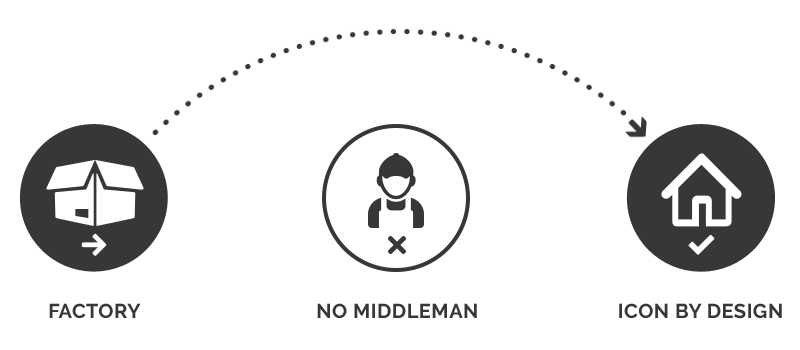Scandinavian vs. Mid Century Modern Style

When it comes to home decor, two popular styles that often come to mind are Scandinavian and Mid Century Modern. Both styles are known for their sleek, minimalist designs and focus on functionality, but they also have distinct differences in terms of materials, colours, and history. In this article, we'll take a closer look at both styles to help you understand their key characteristics and determine which one might be the best fit for your home.
Materials
One of the main differences between Scandinavian and Mid Century Modern styles is the materials used. Scandinavian style is characterised by the use of natural materials such as wood, leather, and wool. The focus is on creating a warm and cosy surrounding, and this is often achieved through the use of these natural materials. Wood is a particularly prominent feature in Scandinavian design, with pieces such as dining chairs, tables, and shelving often made from wood.
Mid Century Modern style, on the other hand, often incorporates a wider range of materials. In addition to wood, you might see furniture made from materials such as metal, plastic, and glass. The goal of Mid Century Modern design is to create a sense of sophistication and elegance through a well-thought out combination of these materials
Colours
Another key difference between Scandinavian and Mid Century Modern styles is the use of colour. Scandinavian design is known for its use of light, neutral colours such as white, gray, and beige. These colours are often used to create a sense of openness and simplicity, and they help to reflect light, making the space feel brighter and more welcoming.
Mid Century Modern style, on the other hand, tends to incorporate a wider range of colours. While neutrals are still common, you might also see pops of bold, vibrant colours such as yellow, orange, and red. These colours are often used to add a sense of playfulness and whimsy to the space.
History
Scandinavian design has its roots in the design movements that emerged in the 1950s in the Scandinavian countries of Denmark, Sweden, and Finland. These movements were characterised by a focus on functionality and simplicity, and they were heavily influenced by the region's natural landscape and climate. The goal of Scandinavian design was to create functional, aesthetically pleasing pieces that were also affordable and accessible to the average person.
Mid Century Modern style, on the other hand, emerged in the United States in the 1940s and 1950s. It was influenced by a number of different design movements, including Bauhaus and Art Deco, and it was characterised by a focus on clean lines and geometric shapes. Mid Century Modern design was often seen as a response to the ornate and overly decorative styles that were popular at the time, and it was meant to be a more streamlined and modern alternative.
Scandinavian Furniture Vs. Mid Century Modern Furniture
Scandinavian furniture is known for its simple, functional design. Pieces often feature clean lines and a minimal number of decorative elements, with the focus instead on creating a sense of functionality and comfort.
Common pieces of Scandinavian furniture include dining chairs, tables, and shelving, which are often made from wood and feature a natural finish. You might also see pieces made from leather or wool, which add a sense of warmth and cosiness to the space.
Mid Century Modern furniture, on the other hand, is characterised by its use of minimal geometric shapes. Common pieces include dining chairs, tables, and shelving, which are often made from a range of materials including wood, metal, and plastic.
You might also see furniture made from glass, which adds a sense of lightness and openness to the space. In addition to traditional furniture pieces, Mid Century Modern design often includes unique, eye-catching accents such as abstract artwork and sculptural lighting fixtures.
Scandinavian Dining Chairs Vs. Mid Century Modern Dining Chairs
When it comes to dining chairs, Scandinavian style often features pieces made from wood with a natural finish. These chairs are typically designed with comfort in mind, with a focus on creating a cosy and welcoming atmosphere around the dining table. You might see chairs with curved backs and padded seats, or chairs with simple, straight lines and a minimalist design.
Mid Century Modern dining chairs tend to be more sleek and sophisticated in design. They often feature clean lines and vibrant geometric shapes, and they might be made from materials such as metal, plastic, or glass. You might see dining chairs with curved backs and padded seats but you'll also find chairs with more diverse but still streamlined designs.
Scandinavian Living Room Furniture Vs. Mid Century Modern Living Room Furniture
Scandinavian living room furniture often includes furniture pieces such as sofas, armchairs, and coffee tables. The goal is to create a cosy and welcoming atmosphere, and this is often achieved through the use of comfortable, functional furniture.
As you would expect, Mid Century Modern living room furniture tends to be more sophisticated in design. You might see pieces such as sofas, armchairs, and coffee tables made from a wide range of materials such as metal, plastic, and glass. Typical of the style, these pieces often feature clean lines, geometric shapes, and bold, vibrant colours.
Scandinavian and Mid Century Modern styles are both characterised by their focus on functionality and simplicity. However, they differ in terms of the materials and colours used, as well as their history and overall aesthetic. Scandinavian style is known for its use of natural materials and light, neutral colours, while Mid Century Modern style incorporates a wider range of materials and bold, vibrant colours. Ultimately, the choice between these two styles will depend on your personal preferences and the look and feel you want to create in your home.
Recent Posts
-
1
-
2
-
3
-
4
-
5
-
6
-
7
-
8
-
9
-
10






 1300 715 719
1300 715 719 Showrooms
Showrooms





















